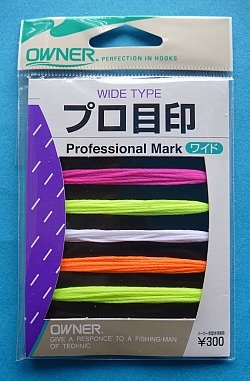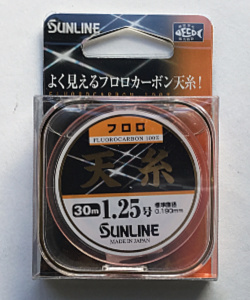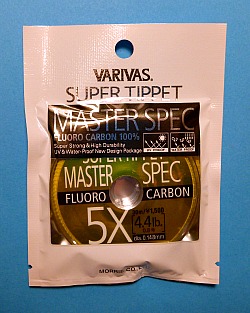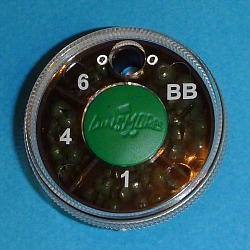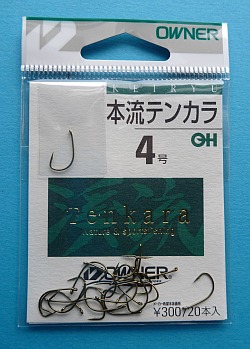Keiryu Lines
Keiryu fishing is becoming increasingly popular in the US.
TenkaraBum.com has been offering keiryu rods since 2012. Up until recently, though, most have been
used for tenkara fishing. That is changing and more people are using the
rods as they are used in Japan (or at least, closer to the way they are
used in Japan), with extremely light lines, markers, split shot and bait. Some do use weighted artificial nymphs instead of split shot and live bait.
With the increased interest in keiryu fishing, I have been getting more and more questions about the construction of keiryu lines. I had hesitated to write a page on keiryu lines because the way I make them is not the way they are generally made in Japan. I did not want to mislead people or chart a new course, but the questions have reached critical mass.
I think it
is perhaps better to provide some guidance, with the caveat that
although these lines work for me they are not what you would find in
Japan. (What actually is used in Japan would take a completely new page with extensive diagrams because we do not have the proper terminology to easily describe what is used.)
Keiryu lines are considerably lighter than tenkara lines and are essentially tippet material for the full length of the line. They do not need to be hi-vis because keiryu yarn markers are tied around the line for strike detection.
I use 3 or 4 markers of different colors, 2-3" apart, with the lowest one kept above the water's surface.
In YouTube videos, you will generally see Japanese anglers using markers 6 or 8" apart. I started out keiryu fishing with markers about 8" apart but found them to be more visible if they were closer together.

The knot that is used allow you to slide the markers up or down the line to adjust for water depth. If tied tightly the knots will then stay where you put them.
Keiryu anglers use split shot to get their bait down to the fish and they cast the weight of the shot rather than the weight of the line. Not only can the line thus be pretty light, lighter is better.
The lighter the line, the less it sags from its own weight. Lighter line also experiences less wind resistance during the cast and is affected less by wind after the cast is made.
There is also less resistance in the water, making it less likely that fish will feel tension on the line. Trout will spit out even natural bait if they feel tension. Reducing resistance of the line in the water also makes it easier to hook the fish. Finally, and perhaps most important, the thinner and more supple the line the more natural the drift of your bait or fly.
Because the line is almost weightless and the weight of the split shot is holding it tight, keiryu anglers are able to fish with a line that is virtually straight from the rod tip to the split shot. That allows the angler to feel most takes, even surprisingly subtle ones. However, if you fish flies and fish only by feel, you will miss a lot of strikes. If you fish with bait and fish only by feel, fish will get more deeply hooked fish.
The split shot is attached to the line perhaps 8" or so above the hook. There is a little slack between the shot and the hook, but very little. Anglers who fish weighted artificial nymphs can eliminate even that little bit of slack, fishing a tight line from the rod tip all the way to the fly.
With a very long rod and a line one to four feet shorter than the rod, keiryu anglers can fish with their line entering the water almost vertically. Drag is almost nonexistent and cross currents are very nearly irrelevant. That is a huge advantage! Of course, there is a disadvantage that goes with it.
With a very thin line and a round split shot, the split shot will act like a plumb bob and will want to hang straight down from the rod tip. You cannot cast out and have it stay out. If you cast out it will come back in (which is essentially drag, because your bait or fly is not drifting with the current, it is drifting across the current to try to get back to directly under your rod tip).
That is probably the main reason keiryu rods tend to be quite long. If you are fishing under your rod tip you want the rod tip to be pretty far away.
Keiryu Line Construction
Keiryu lines are often constructed in three sections. The upper section, which attaches to the rod, is made from thicker and stronger line than the middle and lower sections. The middle section is the main part of your line, and is longer than either the upper or lower sections. The lowest section, to which your hook is tied, is the weakest and the shortest.
If you use the same line strength from the rod tip all the way to the
hook, when you have to break off a snag you will find as often as not that the line breaks at your rod tip
not at your hook or split shot, causing you to lose your entire line.
You don't want to have to re-tie your marker knots in the middle of the
stream and you certainly don't want to leave 10 to 15 feet of line in
the stream to snag other anglers' hooks.
The upper section is called the "tenjo" line. Having it a bit thicker and stronger than the rest of the line yields two or
three benefits. Being thicker, it is less likely to tangle, but if it
does get tangled it is easier to untangle. Being stronger, if you get a
snag and have to break off, the break will occur in the weaker, lower
part of the line so you will not lose your entire line.
A possible third benefit is visibility. Some tenjo lines are hi-vis, which makes them a bit easier to see. They are still very thin, so they are only a bit easier to see, but a visible line attached to the rod tip points to your markers, which makes it easier to spot the markers at the beginning of the drift. The Sunline Tenjo line is extremely visible.
I make the Tenjo line about 6' long for a 6.3 or 5.4m rod, although if you fish with a shorter rod (3.9 or 4.5m) a 4' tenjo line would be sufficient.
In Japan, some tenjo lines are adjustable for length. This would allow you to adjust the length of your line enough to use the same line with both lengths of a two position zoom rod. I am told the primary function is to allow adjustments to make up for line lost when having to tie on a new hook to replace one lost to a snag.
The Tenjo line is useful but optional. I would very strongly urge you to make your keiryu lines of AT LEAST two sections, though!
The middle section is thinner (weaker) than the Tenjo line and is the portion to which the markers are tied. The lowest section of the line, to which the hook and split shot are attached, should be the weakest. For this lowest section I generally use 6X - 8X. If (when) your hook or shot gets caught on rocks and you have to break off, you want to lose as little line as possible. You definitely do not want to lose the section of line with your markers (having to retie the markers is a pain).
I'll cover the lowest section next, because you should determine the length of the lowest section before calculating the length of the middle section.
The diagrams of Japanese keiryu lines I've seen suggest that the lowest section can be relatively short, just long enough to get the split shot a reasonable distance away from the hook. With the split shot generally placed about 8" above the hook, this section of line only needs to be about 10" long.
However, I think we should take a lesson from Zero fishing,
which is a niche within keiryu fishing that uses small hooks, small
shot, soft rods and the lightest line possible to give the bait the most
natural drift and to minimize any tension on the line that could alert
the fish.
Thus, instead of a 10" light third (lowest) section, I would suggest that the third section should be equal to the depth of the shallowest water you expect to fish. You want the line that is under the surface to be as thin as possible. You don't want it to be too long, though, because you will want to position the lowest yarn maker close to the surface, and you will not be able to slide it down past the knot or tippet ring that joins the middle and lowest sections.
The length of the middle section is the most variable, depending on rod length and your own personal preference for line length - and perhaps depending also on water depth. I use a total line length, rod tip to hook, about 4' shorter than the rod for a 6.3m rod, about 3' shorter than the rod for a 5.3 or 5.4m rod, 2' shorter than the rod for a 4.5m rod and rod length or a foot shorter for a 3.9m rod.
With a tenjo line of 4-6', and a third section equal to the depth of the shallowest water you expect to fish, the length middle section is based on the following equation: Total line length (which for me is 2-4' shorter than therod) minus tenjo length, minus the lowest section length (the depth of the shallowest water you will fish). For example, with a 17' rod, my total line length (3' shorter than the rod) would be 14'. With a 5' tenjo line and a minimum water depth of 2', the middle section would be about 7' (14-5-2=7).
Even though a weaker tippet section should be used between the main line and the hook, if you will be fishing where your main line could get caught in overhead tree branches or in either sticks or logs in the water, it would be wise to limit the middle section to the rod manufacturer's maximum tippet recommendation. I generally use Varivas fluorocarbon tippet material for the middle section of keiryu lines. Depending on the rod (and the presence of overhead branches) it might be anywhere from 3X down to 7X.
I connect all the sections with tippet rings. They are easy to use and keep you from losing a few inches of line each time you have to replace either of the lower sections.
For split shot, I generally use a single BB shot, although when fishing a deeper run with faster current (or in heavier wind) I will occasionally use two BB shot. In shallower streams, a #4 or even #6 might be sufficient. In streams that are less than knee deep and generally even shallower, I will use a light tenkara line to provide casting weight, and no shot at all. Please see my Ultralight Worm Fishing page.
When deciding on bead size for fishing two or even three weighted nymphs, consider the total weight required to make your cast and consider the weight required to get the nymphs to fishing depth quickly.
Most Japanese keiryu anglers use eyeless hooks. Japanese bait hooks all
seem to be eyeless. Although it is not terribly difficult to snell a
hook while standing in the middle of a stream, it really is a bit easier
to snell a number of hooks at home, sitting down and with good light.
That way, when you lose a hook to a snag it is no trouble to just tie on another pre-snelled hook, squeeze on a new split shot and get back to fishing. The Daiwa 1500SK Keiryu line holders can hold several of the pre-snelled hooks, as well as a couple tenjo lines and a few main lines of different lengths.
Of course, there is no rule saying your must use eyeless hooks. The Owner Mainstream tenkara hooks are quite similar to many bait hooks and come with eyes, making snelling unnecessary.
When using smaller baits (and I generally use small red wigglers, no more than an inch and a half long) I have pretty much settled on size 20 Varivas 2300 midge hooks, and have been pleasantly surprised at their hooking and holding ability.
Even smaller hooks work surprisingly well. The following photos are of fish caught with size 28 hooks. The fish are not going to notice a hook that small until it is too late. Also, for size 20 or 28 hooks, you don't have to strike to "set the hook." All you have to do is tighten the line.
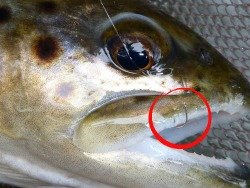 Size 28 Varivas 2300 Midge Hook
Size 28 Varivas 2300 Midge Hook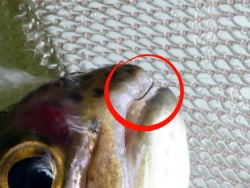 Size 28 Varivas 2300 Midge Hook
Size 28 Varivas 2300 Midge HookTo get the most natural presentation (and the most takes) you really do want the longest rod you can get away with, the lightest line you can get away with, the lightest split shot you can get away with and the smallest hook you can get away with. You don't absolutely need the smallest bait you can get away with, but you do want it to be small enough that the fish will take the whole thing (with the hook) into it's mough at once. Trout are used to eating little things. You really don't need big baits.
TenkaraBum Home > Keiryu Lines
“The bitterness of poor quality remains long after the sweetness of low price is forgotten” - Benjamin Franklin
"Be sure in casting, that your fly fall first into the water, for if the line fall first, it scares or frightens the fish..." -
Col. Robert Venables 1662
As age slows my pace, I will become more like the heron.
Warning:
The hooks are sharp.
The coffee's hot.
The fish are slippery when wet.
Beware of the Dogma
What's in stock?
Suntech Tenkarakyo 40F Tenkara Rods
Suntech Kurenai II AR39F
Seiryu Rods
Coming Soon
Latest Pages
If you enjoy spin fishing or baitcasting please visit my sister site Finesse-Fishing.com.
